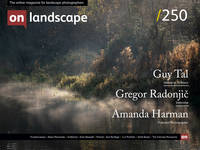Exploring small scale 6:17 in monochrome and colour

Keith Beven
Keith Beven is Emeritus Professor of Hydrology at Lancaster University where he has worked for over 30 years. He has published many academic papers and books on the study and computer modelling of hydrological processes. Since the 1990s he has used mostly 120 film cameras, from 6x6 to 6x17, and more recently Fuji X cameras when travelling light. He has recently produced a second book of images of water called “Panta Rhei – Everything Flows” in support of the charity WaterAid that can be ordered from his website.
It is nearly 25 years ago now that I first switched to a medium format film camera from 35mm. That was to a Mamiya 6 with a 6x6 aspect ratio, which I embraced with some enthusiasm (undoubtedly influenced by the work of Fay Godwin, Michael Kenna and Charlie Waite). A few years later I got a good deal on a used Linhof Technorama 617s and started to explore the world of panoramic photography (initially influenced by the work of Colin Prior, and later Ken Duncan’s books Australia Wide and America Wide). The Linhof was taken on several trips with the Mamiya 6 (including through multiple security checks in the United States immediately after 9/11, but without any real problems apart from the long, long queues). I cannot remember now why I sold or traded the Linhof, but its loss was soon regretted and it was replaced by a Fuji 617 (the Linhof had already dramatically increased in second-hand value; the Fuji less so).
The point of this potted history is that over the period of time of using these film cameras I became very used to composing in the 1:1 and 6:17 formats. They were generally used for different purposes (1:1 often for more intimate landscape shots; 6:17 for the more extensive view). This then carried over to the digital era. One of the features I looked for in selecting a digital camera was the ability to show different aspect ratios in the viewfinder (such as an early purchase of a Fujifilm X10 for travel), particularly the 1:1 ratio. It is much more satisfying to see the crop in the viewfinder rather than impose it later in post-processing, even if working from RAW files that are saved at the full sensor size. Some manufacturers still do not do this (it has been a really good excuse not to have to think about buying a Leica for example). The 6:17 format has not often been supported, at least not until the appearance of the Fuji GFX series of cameras and then in the form 24:65, which was the aspect ratio of the Fuji TX-1/2 35mm cameras, also produced for Hasselblad as the XPan (all of which are now astonishingly expensive given the potential for electronic shutter failure1). 24:65 is not exactly 6:17, but then a 6:17 film negative was not exactly 6:17 either but rather 56:168 (just slightly wider than 24:65).



